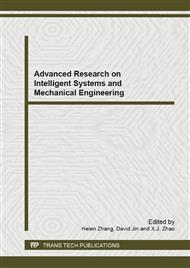p.312
p.317
p.321
p.326
p.333
p.337
p.341
p.346
p.353
Study on Periodic Time Series of Rotating Machines Using Multifractal Theory Based on Mechanical Mechanics
Abstract:
The oscillating or cyclic time behavior can characterize many processes. This holds for rotating machines. The vibration signals of them are periodic or contain periodic parts, which can be used for fault diagnosis for the rotating machines. The periodic time series of the superposition of two oscillations were investigated by the multifractal theory in this study. The wavelet transform modulus maxima method was used for the singularity spectrum computations. From the results, we can find that when the amplitude, frequency or the phase difference changed, the width and the peak position of the singularity spectrum changed significantly. Therefore, a new measure - the width and the peak position of the singularity spectrum – can be used for the periodic signals.
Info:
Periodical:
Pages:
333-336
Citation:
Online since:
January 2013
Authors:
Keywords:
Price:
Сopyright:
© 2013 Trans Tech Publications Ltd. All Rights Reserved
Share:
Citation:


